The best of local oysters and NSW wine came together under blue skies and the backdrop of the Sydney Harbour Bridge for the annual Oysters at the House.
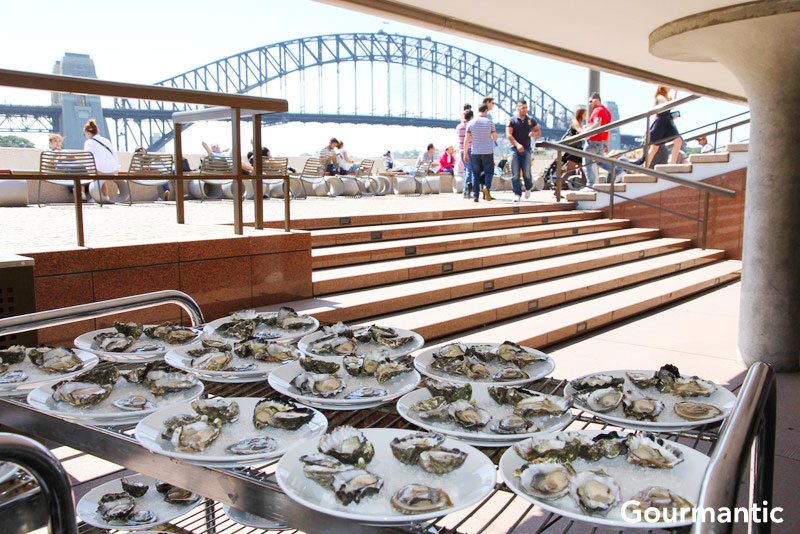
Oysters at the House
The event, which has been running for eleven years, was an initiative of the department of primary industry to reinvigorate the oyster industry after the QX disease in the Hawkesbury wiped it out in one season.
Set at the Opera Kitchen, visitors exchanged tokens for freshly-shucked oysters and wine tastings. Two masterclasses were presented by John Susman, Simon Marnie and Lyndey Milan, including demonstrations on how to shuck oysters and pairing various oysters to local wines from NSW.
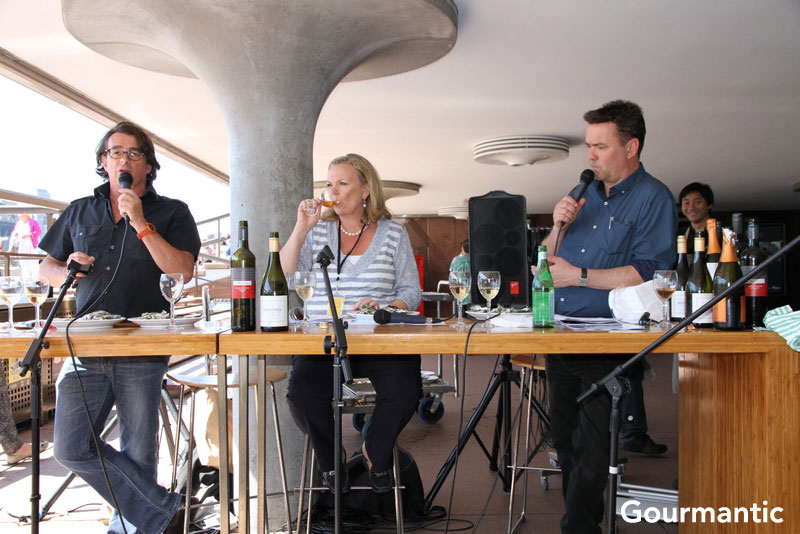
L-R: John Susman, Lyndey Milan, Simon Marnie
Types of Oysters
Australia grows three types of oysters.
1. The Sydney Rock Oyster is grown along 1500 km along east coast of Australia and is endemic to the waters. They spread from south east Queensland to the Victorian border and their flavour reflects the husbandry of the grower.
2. The Pacific Oyster is not native to Australia but originates from Hiroshima in Japan. It is prolifically farmed, have a creamy mouthfeel and often eaten full of spawn.
3. The Angasi Oyster is native and one of the original oysters in Australia with a round, flat shell that resembles a clam.
How to Shuck Oysters
It is generally faster to front shuck an oyster. Hold with ear facing out, position in tea towel, insert knife at 15 degrees, wrist twist, slide knife to 2 o’clock position and twist.
How to Store Unopened Oysters
Unopened rock oysters can keep for 2-3 weeks at 14-18ºC. Pacific Oysters are best kept in the coolest part of the fridge, in the crisper. Angasi oysters should be kept in the vegetable crisper with weight on top so they don’t open.
Oysters are best served at ambient temperature not on ice. They can be put under ice for 20 minutes which makes them easier to shuck and takes the edge off top the notes of oyster.
Masterclass 1
The first masterclass, six oysters were presented, paired with Oakvale Sparkling Apple Cider 2012, Scarborough Chardonnay 2009 from the Hunter Valley and Freeman Wines Rondo Rose 2012.
Smoky Bay Pacific Oyster (South Australia) comes from the West Coast of the Eyre Peninsula They grow in a large shallow bay with calm waters dominated by shallow stretches of sea grass, sand flats and mud flats which contribute to their lettuce/cucumber flavour on back palate.
St Helen’s Pacific Oyster (Tasmania) comes from Moulting Bay in the St Helens region of North East Tasmania. It gets its food supply from both the rivers that run into the bay and the tidal flows from the Tasman Sea. The oyster is creamier, more vegetal due to eating more vegetation, with some tannins on the back palate.
Nambucca River Sydney Rock Oyster (NSW) has one of the best rock oyster growing regions in Australia due to the short and fast flowing river being fed by run-off from the rains. The oyster has a deep colour, a greenish hue which is a reflection of the vegetation in the river. There is no intensity of salt, the texture is a little chewy and has a slight nutty flavour.
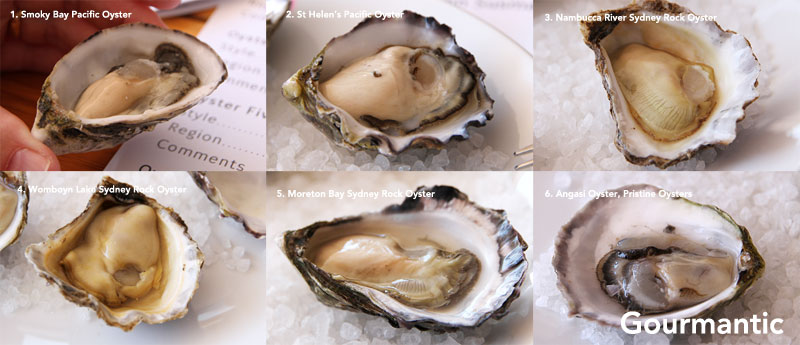
Masterclass 1 Oysters
Womboyn Lake Sydney Rock Oyster on the south coast is the furthest southern spot that oysters are grown. They are fed by rivers from the snowy mountains and have perfect growing conditions. The oyster is slightly milder in flavour, a little fruity and finishes with a long, sweet back palate.
Moreton Bay Sydney Rock Oyster comes from South East Queensland and grows in warm waters. This is a unique oyster that is full of flavour and picks up mineral characteristics.
Angasi Oyster from Pristine Oysters, is difficult to find in stores. These are very fragile, slow-growing and they spawn out of water. Like Belon in France, it has vegetal and mineral characteristics and a lot of depth of flavour.
Masterclass 2
The second masterclass had nine oysters paired with Logan Vintage ‘M’ Cuvee 2009, A Retief Sauvignon Blanc Semillon 2011 and Ross Hill Pinnacle Pinot Gris 2011.
St Helen’s Lease 65 Pacific Oyster Farm (Tasmania) is creamy, sweet, lettuce-like with a saltiness. At the time of tasting, it had two more weeks before it spawns.
Smoky Bay Pacific Oyster from the west coast of South Australia, has vegetal notes, of lettuce, watercress and summer cucumber.
Coffin Bay Pacific Oyster (South Australia) has a clean front palate, more salty than creamy and smells of the sea.
Broken Bay Pacific Oyster (NSW) has a lot of texture and combines the flavour of Pacific and rock oysters. Its unique flavour is rich, creamy and buttery in the mouth.
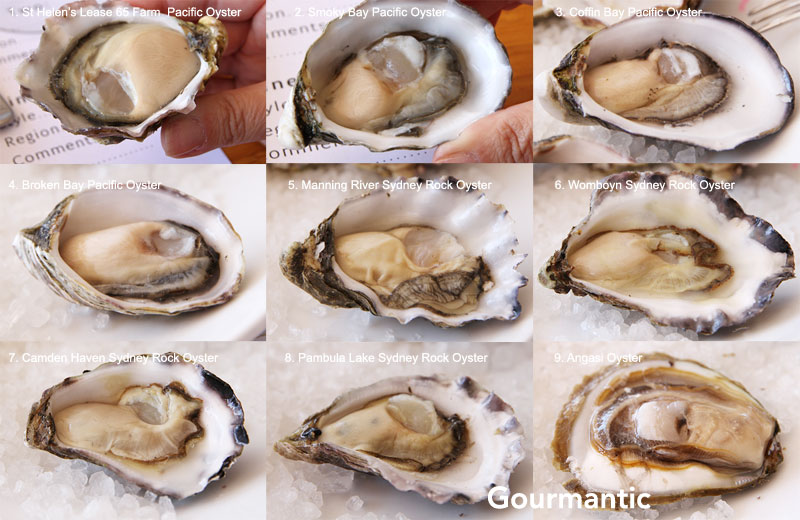
Masterclass 2 Oysters
Manning River Sydney Rock Oyster from the north coast has two entry points, good water flow and sub-tropical region of northern NSW results in a sweeter, more delicate, intense oyster with melon characters and citrus notes.
From the far south coast of NSW, the Wanpengo Lake Rock Oyster has a briny zing, and goes well with a young Hunter Semillon, a, classic wine for rock oysters according to John Susman.
Camden Haven Sydney Rock Oyster had a touch of green almond, cucumber, and is a “cracking example of rock oysters”.
Pambula Lake Sydney Rock Oyster from South Coast has mineral characteristics, slightly vegetal, cucumber and a dry finish. The
Angasi Oyster, served here attached to the top shell, is thicker and meatier.
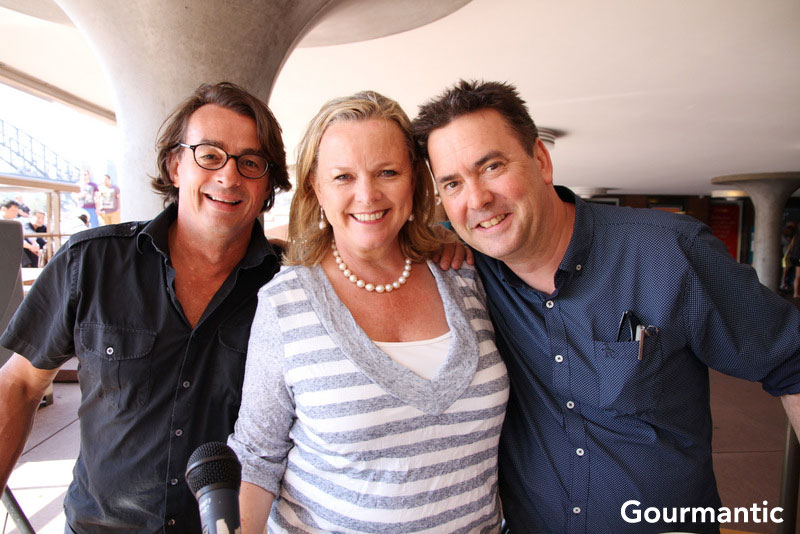
L-R: John Susman, Lyndey Milan, Simon Marnie
Bega Oysters Association
Bega Coast Oysters Inc is the local oyster association for the Bega Valley Shire with four major estuaries:
1. Wapengo Lake Oysters have a crisp flavour, not too creamy and a subtle aftertaste.
2. Merimbula Lake Oysters are creamier, closer to spawning with a colour that changes depending on what they’re feeding.
3. Pambula Lake Oysters have a more briny flavour, less creamy, with a good amount of liquor in the shell.
4. Wonboyn Lake Oysters are lighter in flavour, with a good balance of brine and creaminess.
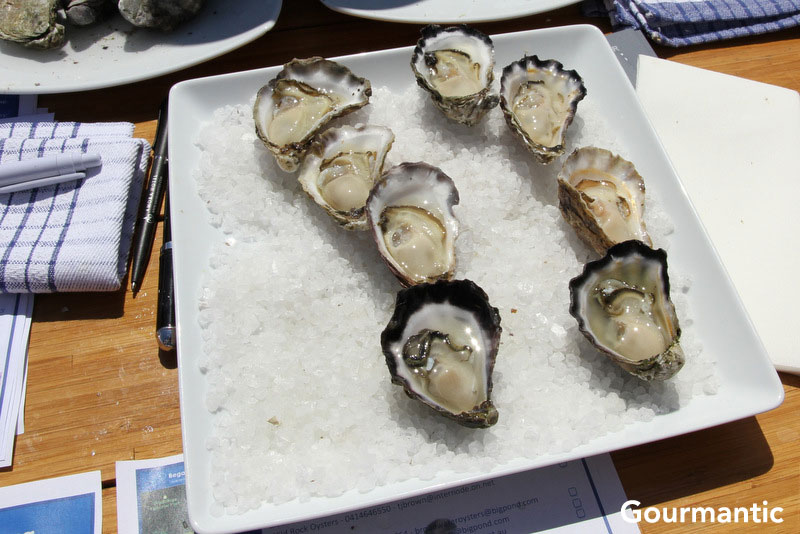
Bega Coast Oysters
Siminis Oyster System
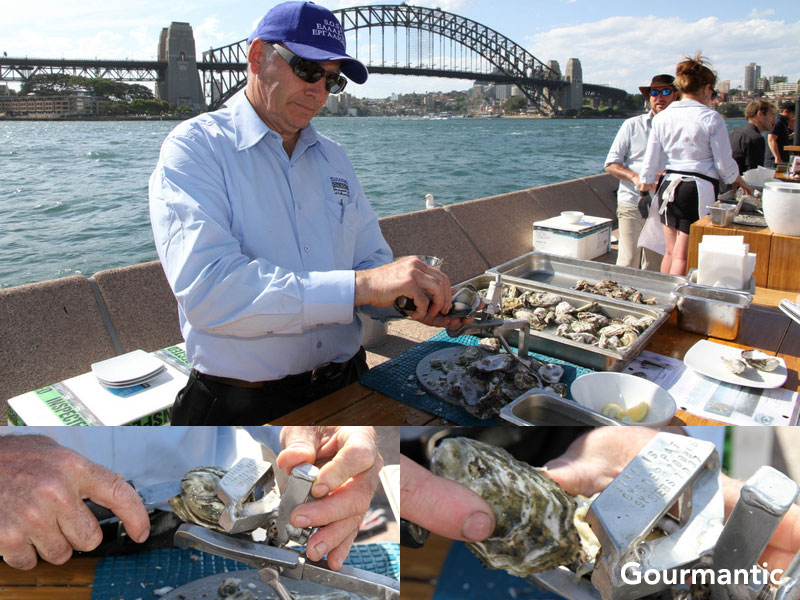
Steve Siminis
Steve Siminis has worked for many years and many versions refining the patented Siminis Oyster System. The System allows for fast, clean and most importantly a safe method for restaurants and venues to open large quantities of oysters. The System is in use at The Morrison Restaurant and Bar where oysters are shucked daily.
A selection of NSW wineries, in addition to those mentioned in the Masterclasses, included Audrey Wilkinson, McLeish Estate, Adina Estate, Chalkers Crossing, Topper’s Mountain Wines, Gundog Estate and Charles Sturt University Winery had a variety of their wines to taste with the oysters along the Opera Kitchen Promenade.
Oysters at the House is supported by NSW Wine and Oysters Australia. A $35 entry fee entitles the person to 10 tokens (1 token = 1 oysters or 1 wine tasting), with additional tokens at $3 each. Masterclasses, which are highly recommended are $25 each.
For a photo gallery of the event, visit Gourmantic on Facebook and “Like” the page.
Photography © by Kevin Burke for Gourmantic – Copyright: All rights reserved.
Opera Kitchen
Lower Concourse
Sydney Opera House
Sydney 2000
Oysters at the House was held on Sunday 18th November 2012 from 12 noon to 6pm. Gourmantic attended the event including the masterclasses as media guests.

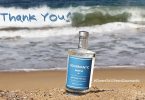


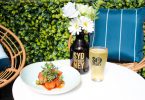

[…] And with summer finally gracing our shores, icy cold Ninki Ichi Kuro-ninki Junmaiginjo sake with oysters and sashimi from the Sydney Fish Market are the go on long hot days and night. […]
[…] producers and chefs that made a big impact on us with events such as the Producers Lunch Forums and Oysters at the House, just to name a […]
[…] plates include Sydney Rock Oysters, fried school prawns with lime aioli, grilled sourdough with trio of dips, chips and aioli, as well […]
[…] has a clean taste which makes it a good choice to enjoy in a shot glass as an accompaniment to oysters or […]
[…] Gibbo on the Rocks with Pambula Oysters […]
[…] nibbles from a menu etched on the mirror and includes tasty bites such as freshly-shucked Pambula Sydney Rock Oysters with palm sugar and lime ($3 […]
[…] by The Morrison Bar & Oyster Room and chef Sean Connolly, the month-long festival celebrates Australia’s best oyster producers and showcases varieties from over six regions. At the media launch, guests were treated […]
[…] Angasi oysters ($6 each) are native and flat, a species that is five to eight years old and not often seen in Sydney restaurants. The oyster is a delicacy with vegetal and mineral characteristics while the Sydney Rock Oyster ($4.50 each) from Port Stevens has a more briny character with a touch of iodine. […]
[…] you can literally feast on a smorgasbord of dishes starting with the popular seafood buffet where Sydney rock oysters abound, along with an array of juicy prawns, mussels, smoked salmon, sushi and […]
[…] freshly-shucked oysters washed down with Australian Prosecco from Dal Zotto Wines in […]
[…] canapés menu is designed to share and includes freshly-shucked Sydney Rock Oysters from Merimbula, zucchini flowers with marinated goats curd and Luxe sprouted bread made with quinoa […]